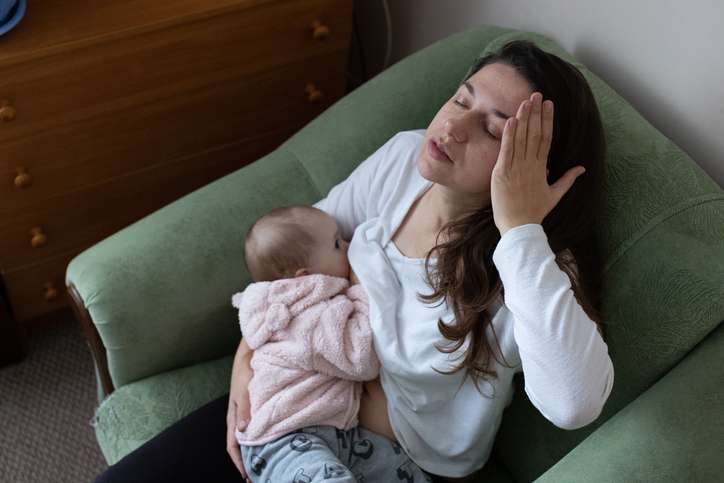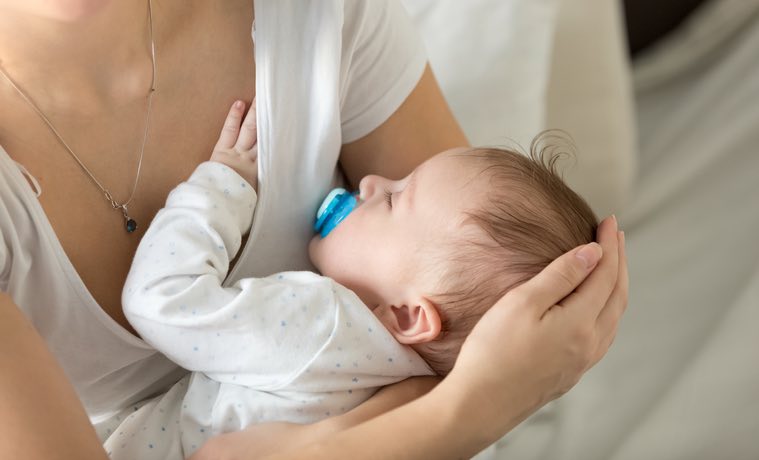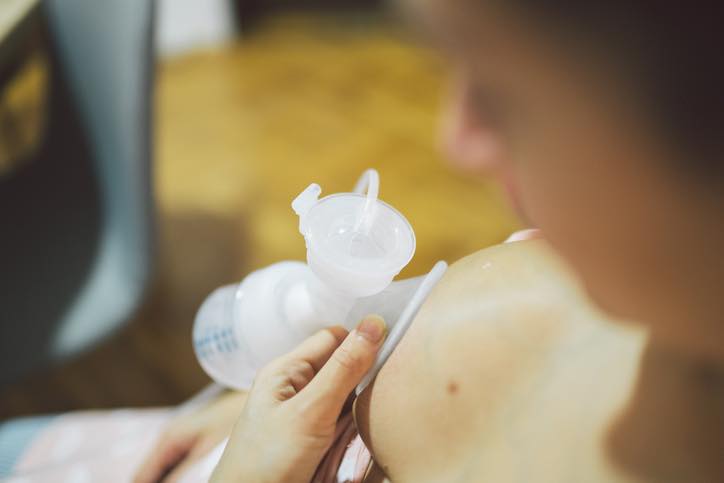Deep Pain After Breastfeeding: Causes & Symptoms of Breastfeeding Pains

Do you have pain after breastfeeding? Breast pain or nipple pain can make feeding your little one challenging.
Whether you have a shooting pain that starts in the areola and spreads across your breast, a dull ache that just won’t go away, or another oh-so-unpleasant sensation, we’ve got the info new mamas need on breast pain, breastfeeding, and how to avoid some of the biggest “booby traps” of nursing!
Related: How to Solve Common Breastfeeding Problems and Pains
Is It Normal To Have Deep Breast Pain After Breastfeeding?
Normal is relative when it comes to your body after having a baby. Pain after breastfeeding might set off alarm bells in your sleep-deprived head. But this type of discomfort isn’t entirely uncommon and it isn’t always a signal that something is seriously wrong.
According to the La Leche League, it shouldn’t hurt to breastfeed. While pain isn’t “normal,” it also doesn’t necessarily mean that you should panic. Many causes of nursing-related breast pain are minor issues that are easy to correct.
This makes understanding the type of pain, the culprit behind the pain, and your overall health important steps to comfortably feeding your baby.
What Are the Causes of Pain After Breastfeeding?
There isn’t one culprit behind post-nursing breast pain. While your mind might wander to the worst-case scenario, several of the possible causes of new or persistent pain actually pretty basic.
The La Leche League notes that common reasons for breastfeeding pain include the baby latch or position of the baby while feeding, teething (if your child is older), and poorly fitting pump flanges (if you also pump). Even though these are some of the most typical causes of pain from breastfeeding, they aren’t the only reasons.
Other issues, according to the La Leche League, that can result in discomfort, aches, tightness, or sharp/stabbing pains include breast infections, engorgement, blocked ducts or plugged ducts, cracked nipples, muscle strain, fibrocystic breast pain, or even premenstrual pain. It’s also possible to experience breast pain after nursing if you are pregnant again, wear a poorly-fitted bra, or have mastitis.
Is Breastfeeding Pain a Symptom of Another Issue?
You obviously don’t want to blame the baby for your post-nursing pain. But every time your little one clamps down on your nipple, it hurts. What gives?
Yes, sometimes there is an underlying cause. An infection, inflammation, cysts, or an injury to the breast can all cause pain. While a medical reason for the deep discomfort is at the top of your mind, you also need to consider how your baby is feeding.
When Baby Latching is Painful

The baby’s latch is a top problem that can result in deep breast pain after feedings. Likewise, if your baby is clamping instead of suckling the areola area, you could also feel deep or sharp breast pain and discomfort.
Along with the baby’s latch or the breastfeeding position, your little one could pass on a yeast infection to your breasts. Oral thrush is a common yeast infection of the tongue and mouth. An overgrowth of the yeast Candida albans can thrive in the warmth and moisture of a newborn’s mouth.
This can result in white spots or sores in the mouth or a whitish velvet-like appearance on the tongue. Whether you gave the yeast infection to your baby or they gave it to you while nursing, it’s common for mothers and infants to pass Candida back and forth.
While you might think of a yeast infection as itchy, the fungus can cause painful breasts after nursing or sore, cracked nipples, according to Mount Sinai Hospital.
Why Do I Get A Sharp Needle-like Pain In My Breast After Feeding?
All deep breast pain is not the same. Some pain may feel achy, while other types of discomfort may include sharp or needle-like nipple pain.
A shooting pain after you nurse could have several possible causes. A thrush infection can cause this stabbing or needle-like pain while you nurse or after feedings. This candida yeast infection can also cause cracked nipples, itchy or burning areola skin, or redness.
Vasospasms are another common cause of deep shooting pain after nursing, according to the La Leche League. As the name implies, vasospasms are spasms (contractions) of the blood vessels. This can happen in nursing mothers who have Raynaud’s phenomenon, if they have a connective tissue disorder or as the result of a poor latch.
A vasospasm reduces the blood flow. As the spasm subsides and the blood rushes back, you may have severe stabbing or throbbing pain in the breast.
What is a Clogged Milk Duct?
Clogged milk ducts can also result in post-nursing pain. This common condition is exactly what the name says. The milk ducts in the breast are clogged or plugged.
As you might expect, this blocks the flow of milk and can lead to breast tenderness, redness, or even a lump. According to the Cleveland Clinic, clogged milk ducts can also cause a milk bleb. This is a small white blister on the nipple.
Blocked or clogged milk ducts are often the result of skipped feedings/pumping sessions, major changes in feeding schedules that don’t allow you to fully empty your breasts or a bad latch.
What is Mastitis?
Mastitis is a breastfeeding-related condition is an infection that causes postpartum pain and discomfort. Other symptoms of mastitis include redness, swollen breasts, a lump or thickening of the breast tissue, or a fever of 101 degrees or higher, according to the Mayo Clinic. You may also feel generally ill or have flu-like symptoms.
The causes of mastitis can include trapped milk, blocked milk ducts, or bacteria that enter the skin through cracked nipples. Risk factors for this common breastfeeding condition include having mastitis in the past, cracked nipples, pressure on the breasts from a poorly fitted bra, improper nursing technique or poor position, stress, smoking, or poor nutrition.
What is Breast Engorgement?
Breast engorgement may look and feel like mastitis. Engorgement can make the breasts swell and feel painful. Even though this condition may feel similar to mastitis, the causes of the two issues are different. Again, mastitis is an infection that causes inflammation. But engorgement happens when the breasts are overfull (engorged) with milk.
The Cleveland Clinic notes that engorged breasts can happen between three and five days postpartum (possibly later if you had a C-section) as your milk flow comes in, if you skip nursing sessions, after a significant change in baby’s feeding schedule, as you wean your child, or if your milk production your baby’s needs.
How Can You Treat Breast Pain After Breastfeeding?
Untreated postpartum breast pain and discomfort can lead to breastfeeding challenges and make it difficult to nurse your baby. This makes it important to treat the cause of the pain as soon as possible.
The specific treatment for deep or shooting pain depends on the cause:
Yeast infection or thrush
Candida yeast thrives in moist conditions. This makes it easy to pass back and forth between your breast and your baby’s mouth. To treat an infection you may need a doctor’s help.
Your medical provider can prescribe a topical antifungal such as clotrimazole or miconazole for you, an oral gel antifungal for your baby, an oral antifungal for you, or a combination of therapies.
Clogged milk ducts

According to the Cleveland Clinic, it’s possible to unclog milk ducts within two days at home. Even though you have breast discomfort, continue to nurse your baby or pump. But this doesn’t mean you should overdo it. Feeding or pumping excessively can add to the stress and make your breasts swell.
Along with maintaining a regular feeding/pumping schedule, you can lightly massage your breasts, take a pain reliever/anti-inflammatory such as ibuprofen, or ice the area. If you develop flu-like symptoms such as body aches and chills or a fever, contact your healthcare provider. The plugged ducts may have turned into an infection.
Mastitis
Treatment for mastitis includes bed rest, frequent or increased breastfeeding sessions, anti-inflammatory medications (such as ibuprofen), alternating cold and warm compresses, breast massage, hand expression or pumping, and changes in baby’s feeding position. You may also need to take prescription antibiotics to clear the infection.
Engorgement
Warm compresses, a warm shower (for 10 to 20 minutes), hand expressing some milk before nursing, and massaging your breasts can help to ease breast milk engorgement pain. Continue to nurse your baby to reduce your milk supply.
Vasospasms
The La Leche League notes that ways to reduce pain from vasospasms include warm, dry heat and reducing caffeine intake. If you do have a Raynaud’s diagnosis, your healthcare provider may need to prescribe a medication that can dilate constricted blood vessels.
Good latch issues
If a good latch is a problem, it’s time to seek breastfeeding support from a pro. A certified lactation consultant can assess the latch problems, suggest different breastfeeding positions, and provide the encouragement you need right now.
Talking To Your Medical Provider About Breast Pain
When should you talk to your healthcare provider about deep pain or stabbing pain after nursing? Some reasons for pain, such as a breast infection, require immediate medical attention.
If you’re not sure why your breasts hurt, the pain doesn’t go away with conservative at-home treatments such as ibuprofen, warm showers, or warm compresses, your nipples crack and bleed, you have a fever, you have other aches, or you just want to feed your baby without any discomfort, contact your OBGYN, nurse midwife, or other medical provider ASAP.
Do you want to learn more about breastfeeding? Get the basics on nursing your newborn right here!

